REVIEW: Gletcher Mosin Nagant M1944 Air Rifle
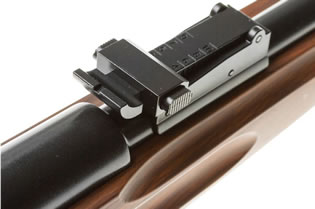
 The Gletcher Mosin M1944 is a C02 bolt-action, magazine fed, replica of the classic Russian WW2 Mosin Nagant Carbine (type M44) rifle.
The Gletcher Mosin M1944 is a C02 bolt-action, magazine fed, replica of the classic Russian WW2 Mosin Nagant Carbine (type M44) rifle.
The Mosin-Nagant is Russia's legendary rifle. The rifle was produced from 1890 to 1950 years. During the Second World War, a new pattern of carbine, called M1944, was adopted as a mass Soviet Army rifle. The M1944 is a one of the latest modification to the popular rifle of WWII.
Shoot, pull back the bolt, shoot again, and once again pull back the bolt. This was the only way to shoot from manual bolt action rifles. The Gletcher M1944 works exactly the same way. The ammunition in the gun barrel for subsequent shots is actually fed into the firing chamber by opening the rifles bolt.
This is a true heavyweight in the Gletcher lineup: 8.21 lbs. One can immediately appreciate the solid feel of the Gletcher M1944 considering the barrel, bolt mechanism, and magazine are all made of metal. The M1944 has a compartment for storing the accompanying retention screw tool in its magazine. With the bayonet in the folded position the M1944 measures just 40.5", with the bayonet fully extended the length comes in at 52". An reproduction M1944 strap is included.
|
Airgun Specifications:
|
Airgun Features:
|
Use the tabs below to view more information about this product.
Additional Gletcher Mosin Nagant M1944 Air Rifle Photos
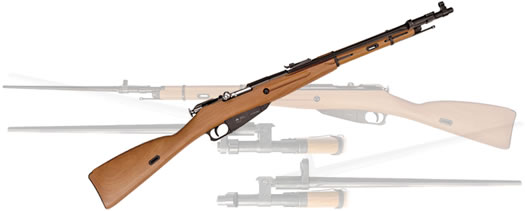

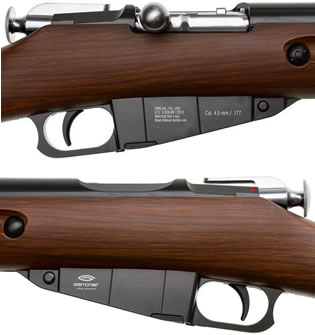
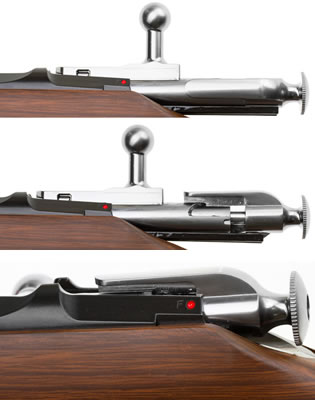

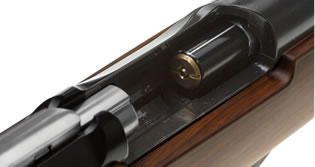
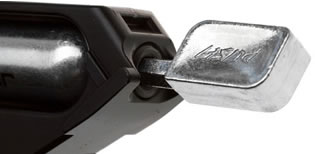
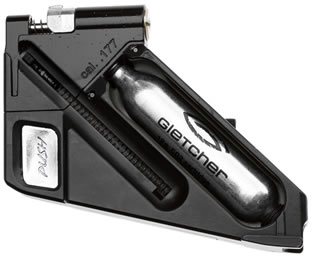

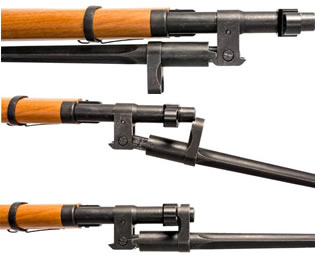
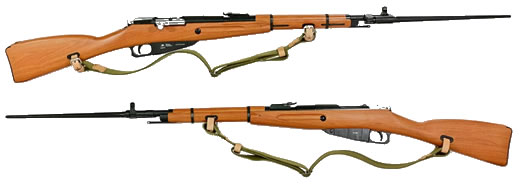
Amazon.com Product and Customer Reviews
Most helpful customer reviews
0 of 0 people found the following review helpful.
![]() Perfection, plain and simple...
Perfection, plain and simple...
By Customer
This is with out the slightest pause the single most beautiful airgun I've ever seen. I received mine about a week ago and I can't put it down.
She's heavy at over 8 pounds but the way she sits in your hands makes that weight a nonissue. She's accurate! That was a big concern for me because my eyesight isn't what it used to be and I worried that I'd have trouble with the stock sights (if anyone is curious I can help you convert this to install a scope mount. Took me A LOT of research, but I figured it out), but so far they've been fine.
I'm a left handed shooter so the bolt action took a little figuring out but I've gotten pretty smooth at it now.
Probably the biggest shock aside from how remarkably quiet it is would be how truly authentic it looks. The plastic stock easily passes for wood! One of my friends whose an avid hunter thought I was trying to play a joke on him when I told him it was a BB gun with a plastic stock.
I can go on and on about this gun but I will just say that while I realize she's a bit pricey she truly is worth every single cent!
TIP: If you get this gun be sure to keep the rubber seal inside the chamber well oiled!! If you notice a drop in velocity break out the pelgun oil and literally slather it on. Let the gun sit facing down for a while so the oil doesn't have anywhere else to go but into the seal, and then run some CO2 through it - no BBs, just air, to force that oil into the seal. Should fix it right up.
1 of 1 people found the following review helpful.
![]() Love that bayonet !
Love that bayonet !
By LO77203
Excellent replica. Handles just like the real thing. Virtually indistinguishable from my ChiCom carbine.
1 of 1 people found the following review helpful.
![]() Enjoyable!
Enjoyable!
By Brad
First, one should note that the people who give this air rifle one star do not appear to own one. Second, I own both this air rifle, and a real Nagant. I enjoy shooting both. The air rifle is a great addition for backyard shooting. It is extremely realistic, and fun/cheap to shoot. The real thing requires that I reload rounds before hand and travel to a range that can accommodate the rifle. Each has it's place. Each is fun to shoot. By the way, there are only 200 of these air rifles in existence, apparently no more will be made. They will be collectors items in the future.
1 of 1 people found the following review helpful.
![]() Worth the price
Worth the price
By Alastair
Didn't buy it from Amazon retailer directly, but do not be discouraged about buying this gun, it has a smooth bolt action and has a hefty weight and great power. Apparently a lot of people dare whining about how it'd not real or its expensive in this review section. Don't mind those autistic retards, they apparently don't know that quality cost money and that not everyone has time to go to a secluded place to shoot a real gun. Worth ever penny in my opinion and I got mine from pyramid air with a discount.
History behind the firearm that inspired the Gletcher M1944 Air Rifle

The 3-line russian infantry rifle M1891, colloquially known as Mosin Nagant is a five-shot, bolt-action, internal magazine fed, military rifle developed by the Imperial Russian Army from 1882 to 1891, and used by the armed forces of the Russian Empire, the Soviet Union and various other nations. It is one of the most mass-produced military bolt-action rifles in history with over 37 million units having been made since its inception in 1891, and, in spite of its age, it has been used in various conflicts around the world even up to the modern day, being plentiful, cheap, rugged, simple to use, and effective, much like the AK-47 and its variants.
 Design and Development
Design and Development
During the Russo-Ottoman War of 1877 1878, Russian troops armed mostly with Berdan single-shot rifles suffered heavy casualties against Turkish troops equipped with Winchester repeating rifles, particularly at the bloody Siege of Pleven. This showed Russian commanders the need to modernize the imperial army.
In 1889, three rifles were submitted for evaluation: Captain Sergei Ivanovich Mosin of the imperial army submitted his "3-line" caliber (.30 cal, 7.62mm) rifle; Belgian designer L on Nagant submitted a "3.5-line" (.35 caliber, 9mm) design; and a Captain Zinoviev submitted another "3-line" design (1 "line" = 1/10 inch or 2.54 mm, thus 3 lines= 7.62 mm).
When trials concluded in 1891, the evaluators were split in their assessment. The main disadvantages of Nagant's rifle were a more complicated mechanism and a long and tiresome procedure of disassembling (which required special instruments it was necessary to unscrew two fasteners). Mosin's rifle was mainly criticized for its lower quality of manufacture and materials, resulting in a slightly larger number of stoppages. The commission voted 14 to 10 to approve Nagant's rifle. However, the head of the commission, General Chagin, ordered subsequent tests held under the commission's supervision during which Mosin's rifle showed its advantages, leading to its selection over the Nagant.
 Technical Detail
Technical Detail
Like the 1898 Mauser rifle, the 1891 Mosin uses two front-locking lugs to lock up the action. However, the Mosin's lugs lock in the horizontal position, whereas the Mauser locks vertically. The Mosin bolt body is multi-piece whereas the Mauser is one piece. The Mosin uses interchangeable bolt heads like the Lee Enfield. Unlike the Mauser, which uses a "controlled feed" bolt head in which the cartridge base snaps up under the fixed extractor as the cartridge is fed from the magazine, the Mosin has a "push feed" recessed bolt head in which the spring-loaded extractor snaps over the cartridge base as the bolt is finally closed similar to the Gewehr 88 and M91 Carcano or modern sporting rifles like the Remington 700. Like the Mauser, the Mosin uses a blade ejector mounted in the receiver. The Mosin bolt is removed by simply pulling it fully to the rear of the receiver and squeezing the trigger, while the Mauser has a bolt stop lever separate from the trigger.
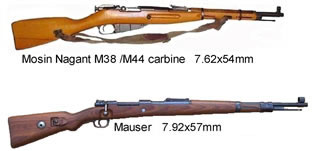
Like the Mauser, the bolt lift arc on the Mosin Nagant is 90 degrees, versus 60 degrees on the Lee Enfield. The Mauser bolt handle is at the rear of the bolt body and locks behind the solid rear receiver ring. The Mosin bolt handle is similar to the Mannlicher: It is attached to a protrusion on the middle of the bolt body, which serves as a bolt guide, and it locks protruding out of the ejection/loading port in front of a split rear receiver ring, also serving a similar function to Mauser's "third" or "safety" lug.
The rifling of the Mosin barrel is right turning (clockwise looking down the rifle) 4-groove with a twist of 1:9.5" or 1:10". The 5-round fixed metallic magazine can either be loaded by inserting the cartridges singly, or more often in military service, by the use of 5-round stripper clips.
 Refinement and Production
Refinement and Production
The 3-line rifle, Model 1891, its original official designation, was adopted by the Russian military in 1891. There have been several variations from the original rifle, the most common being the M1891/30 (commonly referred to as "the 91/30" by shooters), which was a modernized design introduced in 1930. Some details were borrowed from Nagant's design. One such detail is the attachment of the magazine spring to the magazine base plate. In Mosin's original design the spring was not attached to the base plate and, according to the Commission, could be lost during cleaning. Another detail is the form of the clip that could hold five cartridges to be loaded simultaneously into the magazine.
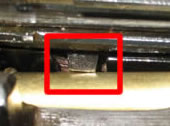
Another detail is the form of the "interrupter", a specially designed part within the receiver, which helps prevent double feeding. The initial rifle proposed by Mosin lacked an interrupter, leading to numerous failures to feed. This detail was introduced in the rifle borrowing from Nagant's rifle. Although the form of the interrupter was slightly changed, this alteration was subsequently borrowed back by the Commission for the Model 1891 Mosin Nagant. During the modernization of 1930, the form of the interrupter was further changed, from a single piece to a two-piece design, as the part had turned out to be one of the least reliable parts of the action. Only the clip loading cartridges and the attachment of the magazine spring to the magazine base plate in subsequent models were designed by Nagant. Considering the rifle could be easily loaded without using a clip, one cartridge after another, the magazine spring attached to the magazine base plate is the only contribution of Nagant to all rifles after 1930.
